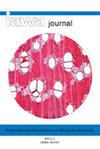Carlquist的木材脆弱性和中形态指数:它们在今天有意义吗?
IF 3.5
3区 农林科学
Q2 FORESTRY
引用次数: 4
摘要
Sherwin Carlquist建立了木质部导管指数和参数来量化植物表现出的中形或旱形的程度。这些指标是为建立植物解剖学定量方法以及功能和生态解剖学发展领域所做的努力的一部分。本文结合目前的理论和实践,讨论了这些参数的来源及其优缺点。导管直径、导管单元长度和导管密度(导管/mm2)仍然是描述和量化植物功能和生态的相关解剖学特征。从功能的角度来看,受Hagen-Poiseuille定律的启发,平均直径可以用水力平均直径(dh)代替。通过冗余和抗栓塞性,容器密度可能与水力安全有关,并且是具有许多狭窄容器的干胚木材的基本特征。尽管血管元件长度与同源性密切相关,但元件长度与同源性之间联系的原因尚不清楚。解剖学指标的使用,如卡尔奎斯特开发和提出的那些,有助于塑造我们对植物水力策略的理解,并将继续在我们将植物解剖学与植物功能联系起来时发挥重要作用。本文章由计算机程序翻译,如有差异,请以英文原文为准。
Carlquist’s indices for vulnerability and mesomorphy of wood: are they relevant today?
Sherwin Carlquist established xylem vessel indices and parameters to quantify the degree of mesomorphy or xeromorphy exhibited by plants. These indices were developed as part of efforts to establish a quantitative approach to plant anatomy and the developing fields of functional and ecological anatomy. In this paper, we discuss the origin of such parameters and their merits and demerits in light of current theory and practice. Vessel diameter, vessel element length, and vessel density (vessels/mm2) remain relevant anatomical characters that describe and quantify plant function and ecology. From a functional perspective, mean diameter can be replaced by hydraulic mean diameter (dh), inspired by the Hagen–Poiseuille Law. Vessel density is presumably linked to hydraulic safety through redundancy and embolism resistance and is an essential feature of xeromorphic woods that tend to have many narrow vessels. Although vessel element length strongly correlates to xeromorphy, the reasons for the link between element length and xeromorphy are unclear. The use of anatomical indices, such as those developed and proposed by Carlquist, helped shape our understanding of plant hydraulic strategies and will continue to be important as we connect plant anatomy to plant function.
求助全文
通过发布文献求助,成功后即可免费获取论文全文。
去求助
来源期刊

IAWA Journal
农林科学-林学
CiteScore
3.40
自引率
15.80%
发文量
26
审稿时长
>36 weeks
期刊介绍:
The IAWA Journal is the only international periodical fully devoted to structure, function, identification and utilisation of wood and bark in trees, shrubs, lianas, palms, bamboo and herbs. Many papers are of a multidisciplinary nature, linking
 求助内容:
求助内容: 应助结果提醒方式:
应助结果提醒方式:


